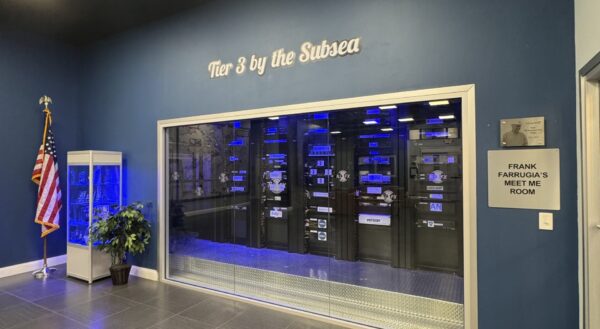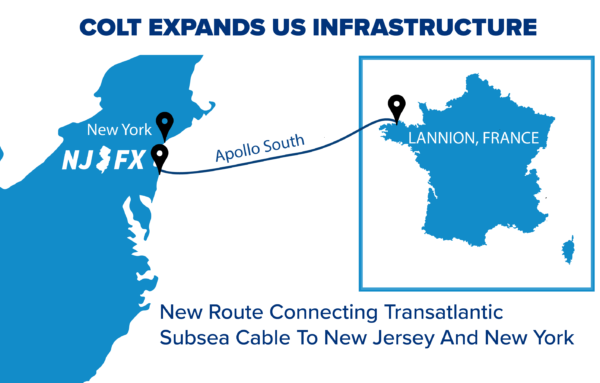
The AI-Ready Cable Landing Station is Coming
NJFX today announced the completion of a comprehensive Basis of Design for a new 10MW high-density AI data hall, delivering an expected 1.25 PUE and 8MW of usable IT load.
Dr. Kapany is colloquially known as the Father of Fiber Optics.
Site Access
October 5, 2022

WALL TOWNSHIP, NJ – Welcome back to NJFX’s Luminaries in Telecom! This month we’re shining a spotlight onto the Nobel Prize-deserving Dr. Narinder Singh Kapany. A man of many accolades, Dr. Kapany was a trailblazing technologist, passionate academic, astute entrepreneur, art aficionado (especially of his Sikh heritage) and an ardent philanthropist. Fortune magazine got it right naming him one the ‘Unsung Heroes of the 20th century’. He not only created fiber optics but used his invention to found multiple successful enterprises that thrive to this day. Dr. Kapany was the first to transmit images through fiber optics in 1954, laying the foundations for high-speed internet technology. Dr. Kapany is colloquially known as the Father of Fiber Optics.
——————————————————————————————————————
As a proud Sikh, born in Moga, India, an especially curious academic from an early age, Dr. Kapany (1926-2020) proclaimed his passions have humble beginnings: “It started when my father gifted me a small camera, I became so curious tinkering around with its inner workings!” This small spark of childhood curiosity luckily led him into the pursuit of learning how our world works through science. While Dr. Kapany was at a lecture in college, his professor was teaching about the nature of light, “Light’s path needed to travel in a direct and linear pathway for maximum efficiency.” Upon hearing this, Dr. Kapany’s gears turned…this simply wasn’t true he proclaimed! Dr. Kapany made it his life’s mission to prove what he knew to be true: Not only could light be maneuvered but light can also be used to communicate! His discoveries about the nature of light served as the basis of fiber optics that we use to this day!
Dr. Kapany swiftly finished his studies in India and, upon entering graduate school at the Imperial College of London in 1952, he realized that he wasn’t alone in his pursuit for the truth behind the nature of light. Decades-long experiments about transmitting light through thin glass filaments were being conducted by researchers across Europe. Unfortunately, post-WWII materials shortages had stalled progress. During this time, Kapany enthusiastically persuaded a would-be mentor, Professor Harold Hopkins, to take him on as a research assistant, leading to a strong bond. Hopkins, a fortified theorist, provided the conceptualizations. Dr. Kapany, who was more technically minded and pragmatic, put words to action. In just two years’ time, the pair announced their discovery in Nature, a leading scientific journal, displaying for the world to see the first fiber optics!
In the following years after the innovation was recognized by the world, in 1960 he penned a cover article for Scientific American. Kapany detailed his findings — literally “writing the book” — on his invention naming the thin strands of glass we all know (and love), Fiber Optics: Principles and Applications. Dr. Kapany seemingly always accelerated the field at the speed of light (pun intended) and became an enterprising entrepreneur touting his invention’s many applications. That same year, he founded Optics Technology serving as Chairman, President, and Research Director for 12 years. Seven years later, the company went public, leading to numerous global partnerships and Dr. Kapany joining the boards of various companies. Never one to rest of his laurels, he was the lead author or co-author publishing 56 papers. His intellectual prowess led to his contribution of an unprecedented 30% of all research in the field at the time!
The media took to calling Dr. Kapany The Father of Fiber Optics, and The Man Who Bent Light. Some publications even reported he had been swindled out of the 2009 Nobel Peace Prize in Physics, which instead went to a colleague and somewhat of a would-be rival, Sir Charles Kao, for his own innovations in fiber optics. Dr. Kapany should be especially remembered for propagating fiber optics into government/corporate research budgets. The sum of Dr. Kapany’s work incapsulates not just fiber optic communications, but a long list of advances in technology such as medical instruments, pollutant research, various types of lasers, biomedical instrumentation, and renewable energy to name a few. Dr. Kapany’s never-ending drive ensured that the world-changing breakthroughs that he and his mentor Hopkins deciphered all those decades ago continued to blossom.
Although he may have been denied his Nobel Prize, in a roundabout way, I’m sure Sir Kao embracing Kapany’s invention so wholly, elated Kapany in somewhat of a paternal sense. Dr. Kapany sadly passed in 2020 at the age of 94, having witnessed how the world embraced his work and leaving behind a deep technological legacy. The article you are reading now is possible through the technology Dr. Kapany developed. Regardless, Dr. Kapany was and always will, be widely beloved by the scientific community having received numerous awards throughout his lifetime. To his name, he had over one hundred patents and was a representative of the National Inventors Council. Throughout his life, Kapany accentuated his Sikh upbringing by founding the Sikh Foundation. He donated his collection of Sikh art to museums, including the San Francisco Asian Art Museum and Montreal’s Fine Arts Museum.
And of course, there is much more to Dr. Kapany’s story, we may return to the story of “The Man Who Bent Light” in the future but for now this concludes this month’s feature in the “Luminaries in Telecom” series. Please feel free to add to the conversation! Had you heard of Dr. Narinder Singh Kapany before? What did you take away from his boundless energy? Sound off in the comments below with any fun facts/specifics that may have been missed! Any suggestions for a person in Telecom history you think deserves a feature send a message to [email protected]. As symbolic tuition to this Luminary, I hope some may plan to visit this exhibit and gaze upon these same works that he found so captivating, possibly taking with you a bit of inspiration!
###
About NJFX:
NJFX is a Tier 3 Carrier Neutral Cable Landing Station campus. Our colocation ecosystem has expanded to over 35 network operators offering flexibility, reliability, and security. Our Wall, NJ location provides direct access to multiple subsea cable systems giving our carriers diverse connectivity solutions and offers direct interconnection without recurring cross-connect fees.

NJFX today announced the completion of a comprehensive Basis of Design for a new 10MW high-density AI data hall, delivering an expected 1.25 PUE and 8MW of usable IT load.

NJFX today announced the completion of a comprehensive Basis of Design for a new 10MW high-density AI data hall, delivering an expected 1.25 PUE and 8MW of usable IT load.

Red Sea conflict threatens Key Internet Cables. Maritime attacks complicate repairs on underwater cables that carry the world’s web traffic.

Red Sea conflict threatens Key Internet Cables. Maritime attacks complicate repairs on underwater cables that carry the world’s web traffic.

Red Sea conflict threatens Key Internet Cables. Maritime attacks complicate repairs on underwater cables that carry the world’s web traffic.

Red Sea conflict threatens Key Internet Cables. Maritime attacks complicate repairs on underwater cables that carry the world’s web traffic.
